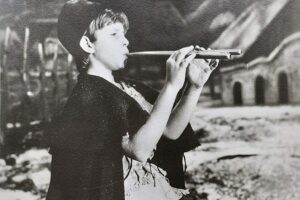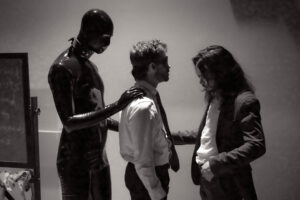

That would be the conclusion, anyhow, after sitting through Apotheosis Opera’s zero-frills, loosely conducted production of Richard Strauss’ Capriccio. The aging composer’s final work, normally set in ancien régime Paris, was given modern-day treatment by the intrepid young company last night at El Museo del Barrio in East Harlem. What emerged was not a great show, but a daring one that made accessibility, and getting the libretto across, its primary goal.
I’ve always felt that Strauss’ “conversation piece for music” sounds like the gung-ho juvenilia of a very young composer, and not the mature product of a 70-something-year-old Strauss. Its heady premise, an allegorical birthday spat over whose contribution to art is more vital—wordsmith or composer?—uses deconstruction as a vehicle for laying bare the whirring cogs and wheels of the theatre. Lots and lots of talk-singing, with a few nostalgic set pieces that, at least in every production I’ve ever seen, always run away with the show.
Plot is relatively action-free. Competing for the affections of a beautiful young Countess named Madeleine (Bonnie Fraunthal), the poet Olivier (Wayne Hu) and musician Flamand (Joe Palarca) are both contributing to her birthday present—a Greco-Roman throwback to be produced by the self-assured director La Roche (Kofi Hayford).
A troupe of secondary characters intervene here and there, but the strenuous through line of philosophy always circles back to that Gordian question about words or music, and the opera ends with a normally breath-stopping orchestral interlude (“Moonlight Music”) followed by a well-known soliloquy from the Countess herself. I won’t spoil the no-surprise ending, but suffice it to say that partisan intellectuals in the audience won’t leave very satisfied.
Maybe with the company’s collegiate audience in mind—on opening night, I was moved by the sight of more than a few young people turning out for their pals in the show—director Lucca Damilano aimed to highlight the story’s casual conversational elements. He also went for update, plying his main characters with modern references (“May I drive you to Brooklyn, Clairon?”), MacBooks, Key Foods butter popcorn, and cell phones.
The idea here is that these figures are modern theater people setting up backstage for the main show. Not a bad conceit, if you like your German opera in English, your Clairon (Phoebe Haines, doing her mannered best) reimagined as a Williamsburg hipster actress, and your chorus of servants reborn as stagehands.
What doesn’t work about this improvement is that Strauss’ sense of humor, already a bit stale when his opera premiered in the 1940s, doesn’t lend so easily to 21st-century modernity, either. In this production, dusty parodic scenes involving Italian Singers (charming Michaelle Trovato and Thomas Killourhy) grabbed at laughs, but felt anachronistic, temporally out of sync with the rest of the show.
In keeping with the production’s relaxed flavor, sets by designer Michael Angel Zaragoza were sparse and unattractive, furnished with backstage scaffolding, couches, and a bar for craft service. Costumes by Allyson Steele were slapdash as well: Flamand in cargo shorts, Olivier in t-shirt and sweats, the Dancer (Danielle Atkinson, following through on Danielle Kipnis’ pedestrian choreo) in unsightly lamé or whatever, the Countess’ amorous brother (Jay Lucas Chacon) sporting a truly odd, pattern-problem ensemble that gave the distinct sense he was about to go hiking after a spin on his yacht. Will someone please fetch the Countess a dress that fits.
Of course, for Capriccio to work its magic, both words and music must be brought to life in equal measure by the orchestra, and especially by the singers inhabiting the main characters. Performances in this outing were committed but uneven. As La Roche, Hayford’s voice was far from evenly produced and his diction mucky, but his presence onstage captivated, particularly in the Director’s celebrated monologue on the merits of theater.
And like so many sopranos before her, Fraunthal played the Countess as a grinning coquette, carousing with the artists in her entourage and, in silver voice, leading them all on. I wish she’d had more chemistry with Hu and Palarca: one of the ongoing problems with Damilano’s blocking, I’ve observed—also apparent in his Fanciulla del West for Apotheosis last year—is an unfocused quality he brings out in his company.
While both in decent voice (although I do worry about Palarca’s labored top notes, which will snuff out his career if he continues to push), poet and composer rarely make conversational eye contact with the Countess, both singing out to the audience instead.
Funny how a single spirited performance can set a show on its feet. Tenor John Ramseyer’s small turn as Monsieur Taupe, La Roche’s narcoleptic prompter, was transcendent and full of brio; his exchange with the Major-Domo (Scott Adam Kipnis), a stage manager in this retelling, was relaxed and loopy, yet still completely present. When they left the stage, we all wanted them back.
I keep hoping artistic director and conductor Matthew Jenkins Jaroszewicz will learn to tone it down a bit at the podium: it was often hard to hear singers over his orchestra, and the instrumentalists were not always on top of Strauss’ denser passages. (Looking at you, horns. That Mondscheinmusik was a nail-biter.) Music often lost its way in this production.
It’s been said that retrospective Capriccio betrays Strauss’ elderly unwillingness to acknowledge the political conflicts of his era. I would argue that the opera’s problems are in fact somewhat vaster, with its recursive inconsistencies of tone (pastiche or profound? self-deprecating or self-celebrating?) and half-baked insinuations of class conflict detracting from the score’s frothier ideas.
But for Apotheosis, these tensions are smoothed over with an ambitious effort to make the characters feel relevant to the present—and the results are mixed. “Give us people who resemble us, and speak in our language,” exhorts La Roche at one point. As usual with this opera, I don’t much relate, musically or verbally, to anyone.
Photo: Steve Malinski

























Comments